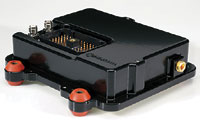 |
| Devices grab hours (above) and fuel. |
Blair Kinker started 2003 with a $42-million equipment budget. But by last spring, the Virginia Dept. of Transportation fleet manager was told he didnt have a penny.
Fiscal belt-tightening is hurting public and private fleets. "We have to make sure that we are capturing utilization numbers. Then we have to make some hard and fast decisions," said Kinker at a Jan. 25-27 Association of Equipment Management Professionals conference in New Orleans. VDOT spending still is on hold this year, he says.
 |
Some managers are attacking the problem with automation. Mike Monnot, Zachry Construction equipment director in San Antonio, said that he is outfitting his $180-million fleet with wireless "GlobalTracs" units from Qualcomm, San Diego.
The cellular trackers look like "black-box" flight recorders and monitor hours and location in real time. They retail for $895 and have a monthly $25 online service fee. Users say they are difficult to justify to executives but pay for themselves by streamlining job-costing, productivity and availability.
Rental houses are using trackers for more accurate billingsuch as for contractors that request a unit be placed "off-rent" but use it anyway. "We tell them Big Brother is on the machines," says Larry Workman, president of Illini Hi-Reach, Lemont, Ill.
OEMs are catching on with their own trackers. Monnot says he used DeereTrax until it was sold to Toronto-based AirIQ in 2002. Caterpillar calls its satellite unit Product Link. Komatsu calls its satellite product KomTrax. And CNH is using Qualcomm to replace its Fleet Link cellular package.
Maintenance consultant Richard LeFrancois, Lakewood, Colo., says that wireless tracking of driver habits and fuel consumption is the next big step. He adds one caveat, though: "Its great to have all this technology, but if you dont use it, you are wasting your money."
(Photo top courtesy of QualComm Wireless Business Solutions,
middle courtesy of EMI-Globle)

Post a comment to this article
Report Abusive Comment